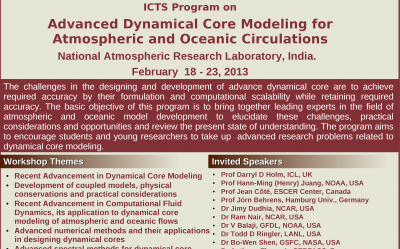This program is being organized as a part of the activities related to the "Mathematics of Planet Earth 2013".
The dynamics of geophysical phenomena are multi-scale in nature and the interaction between different scales makes the flow complex. Therefore, the system of coupled partial differential equations used in weather and climate models becomes complex which generally can only be solved numerically.The accuracy of the predictions obtained by numerical integration of these partial differential equations depends on model formulation, physical conservation principles, hypothesis and approximations used in their formulation and accuracy of numerical method used for the integration. The advanced dynamical core solvers used in atmospheric and oceanic general circulation models comprise of designing of dynamical equations of conservations, latitudinal –longitudinal mesh, discretization method, temporal integration scheme, parallelization, integration on supercomputing platforms etc. The challenges in the designing and development of advance dynamical core are to achieve required accuracy by their formulation and computational scalability while retaining required accuracy. The basic objective of this program is to bring together leading experts in the field to elucidate the challenges, practical considerations and opportunities and review the present state of understanding. In addition, another aim of this program is to encourage students and young researchers to take up advanced research problems related to dynamical core design.
This program is organized on following main themes:
- Recent Advancement in Dynamical Core Modeling
- Development of coupled models, physical conservations and practical considerations
- Recent Advancement in Computational Fluid Dynamics, its application to dynamical core modeling of atmospheric and oceanic flows
- Advanced numerical methods and their applications in designing dynamical cores.
- Advanced spectral methods for dynamical core modeling. Scalable, Efficient, Parallel Computational Environments for modeling of atmospheric and oceanic flows
- Paradigm of multi-core architecture and parallel computing of weather and climate models
 gmail
gmail com
com

